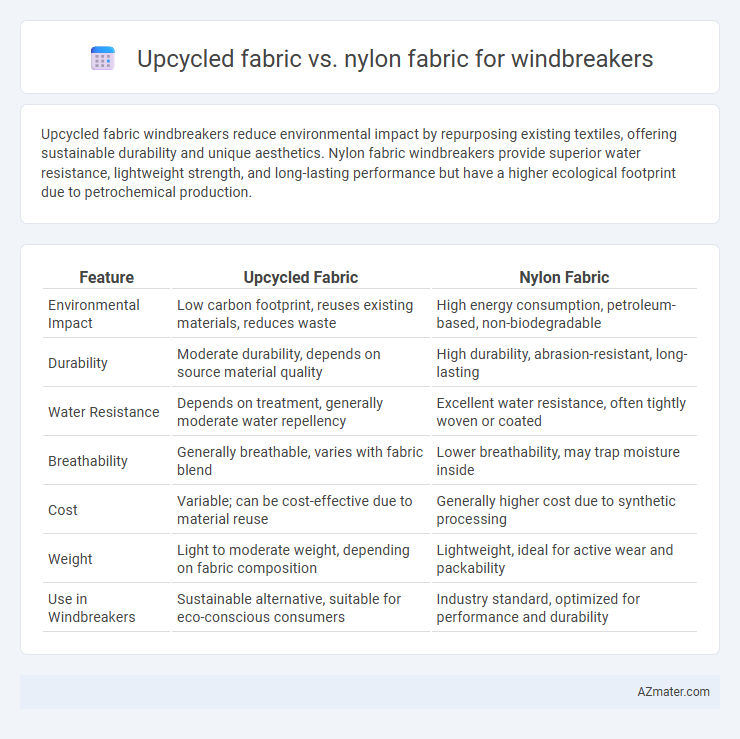Upcycled fabric windbreakers reduce environmental impact by repurposing existing textiles, offering sustainable durability and unique aesthetics. Nylon fabric windbreakers provide superior water resistance, lightweight strength, and long-lasting performance but have a higher ecological footprint due to petrochemical production.
Table of Comparison
| Feature | Upcycled Fabric | Nylon Fabric |
|---|---|---|
| Environmental Impact | Low carbon footprint, reuses existing materials, reduces waste | High energy consumption, petroleum-based, non-biodegradable |
| Durability | Moderate durability, depends on source material quality | High durability, abrasion-resistant, long-lasting |
| Water Resistance | Depends on treatment, generally moderate water repellency | Excellent water resistance, often tightly woven or coated |
| Breathability | Generally breathable, varies with fabric blend | Lower breathability, may trap moisture inside |
| Cost | Variable; can be cost-effective due to material reuse | Generally higher cost due to synthetic processing |
| Weight | Light to moderate weight, depending on fabric composition | Lightweight, ideal for active wear and packability |
| Use in Windbreakers | Sustainable alternative, suitable for eco-conscious consumers | Industry standard, optimized for performance and durability |
Introduction to Upcycled and Nylon Fabrics
Upcycled fabric for windbreakers is made by repurposing textile waste, reducing environmental impact while maintaining durability and breathability. Nylon fabric, widely used in windbreakers, is a synthetic polymer known for its lightweight strength, water resistance, and quick-drying properties. Choosing between upcycled and nylon fabric involves balancing sustainability benefits with performance characteristics like abrasion resistance and moisture management.
Environmental Impact: Upcycled vs Nylon Windbreakers
Upcycled fabric windbreakers significantly reduce environmental impact by diverting textile waste from landfills and minimizing the need for virgin resource extraction. Nylon windbreakers, typically derived from petrochemicals, contribute to greenhouse gas emissions and microplastic pollution during production and disposal. Choosing upcycled fabrics supports sustainable fashion by lowering energy consumption and carbon footprint compared to traditional nylon materials.
Durability and Performance Comparison
Upcycled fabric windbreakers offer a sustainable choice with moderate durability, often incorporating recycled polyester blends that provide adequate water resistance and breathability. Nylon fabric windbreakers excel in durability and performance, featuring superior tensile strength, abrasion resistance, and lightweight, quick-drying properties ideal for active outdoor use. While nylon outperforms in longevity and moisture management, upcycled fabrics contribute significantly to environmental impact reduction through resource reuse.
Breathability and Comfort Factors
Upcycled fabric windbreakers provide enhanced breathability due to natural fibers and eco-friendly production processes that allow better air circulation compared to traditional nylon. Nylon fabric, while lightweight and water-resistant, tends to trap heat and moisture, reducing overall comfort during prolonged wear. Comfort in upcycled fabric also benefits from its typically softer texture, making it more suitable for activities requiring extended movement and flexibility.
Style and Aesthetic Versatility
Upcycled fabric offers a unique, eco-friendly style with distinctive textures and patterns that appeal to conscious consumers, ensuring each windbreaker has a one-of-a-kind aesthetic. Nylon fabric provides a sleek, smooth finish with consistent color options, delivering a modern and versatile look that easily adapts to various fashion trends. Both materials enhance windbreaker design, but upcycled fabric stands out for its artisanal charm while nylon excels in polished, performance-driven style.
Water Resistance and Weather Protection
Upcycled fabric for windbreakers offers effective water resistance through innovative treatments that enhance sustainability without compromising performance. Nylon fabric remains a benchmark for superior weather protection due to its tightly woven fibers and durable water repellent (DWR) coatings, ensuring reliable moisture barrier and wind resistance. Both materials provide essential weather protection, but nylon generally outperforms upcycled fabric in long-term water repellency and abrasion resistance.
Cost and Accessibility
Upcycled fabric for windbreakers often reduces production costs by repurposing existing materials, making it a budget-friendly option compared to nylon fabric, which involves higher manufacturing expenses due to synthetic processing. Accessibility of upcycled fabric depends on local recycling programs and textile availability, whereas nylon fabric benefits from widespread global production and consistent supply chains. Cost-effectiveness and eco-conscious consumer demand drive increased adoption of upcycled fabrics, despite nylon's dominance in durability and weather resistance for windbreaker manufacturing.
Ethical Considerations in Fabric Selection
Upcycled fabric for windbreakers significantly reduces environmental impact by repurposing existing materials and minimizing fabric waste, supporting circular fashion principles. In contrast, nylon fabric, derived from petroleum-based sources, involves high energy consumption and emits greenhouse gases during production, raising concerns about resource depletion and pollution. Choosing upcycled fabric aligns with ethical considerations by promoting sustainability, reducing landfill contributions, and fostering responsible consumption in activewear manufacturing.
Maintenance and Longevity
Upcycled fabric windbreakers often require gentler care, such as cold water washing and air drying, to preserve their unique fibers and prevent wear, resulting in extended garment lifespan. Nylon fabric windbreakers are typically more durable and resistant to abrasion, making them easier to maintain with machine washing and quicker drying times, which enhances their long-term usability. Both materials offer longevity benefits, but nylon's moisture-wicking and quick-dry properties contribute to superior performance in active wear over time.
Conclusion: Choosing the Right Windbreaker Fabric
Upcycled fabric offers an eco-friendly alternative to nylon fabric in windbreaker production by reducing waste and minimizing environmental impact while maintaining durability and water resistance. Nylon fabric provides superior strength, lightweight properties, and excellent wind protection, often favored for high-performance outdoor wear. Selecting the right windbreaker fabric depends on prioritizing sustainability and environmental consciousness with upcycled materials or emphasizing durability and technical performance through nylon.

Infographic: Upcycled fabric vs Nylon fabric for Windbreaker
 azmater.com
azmater.com